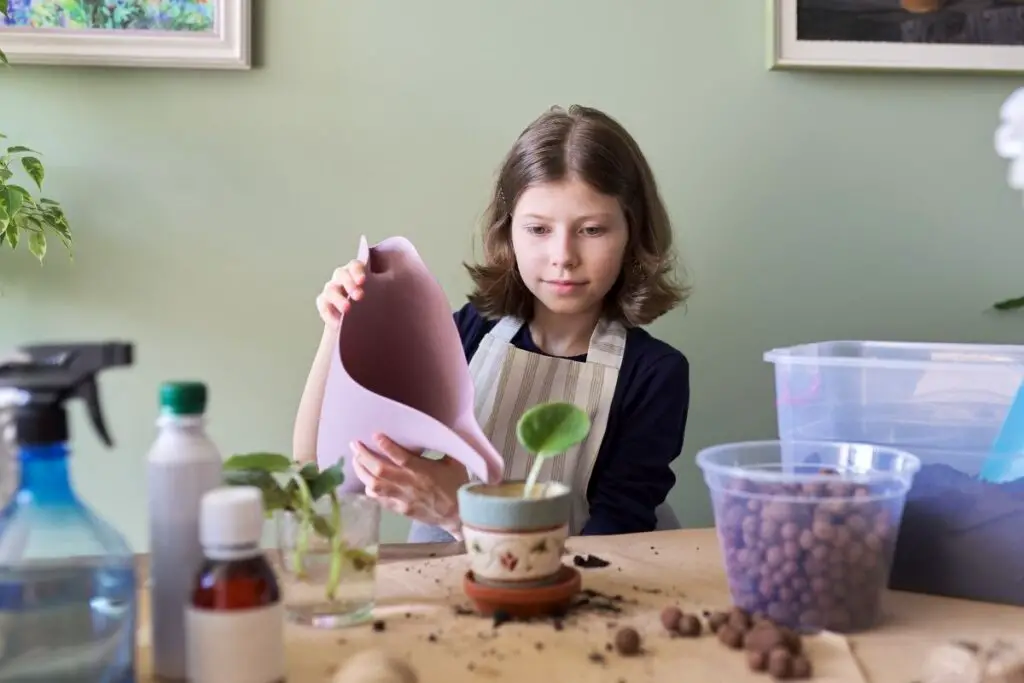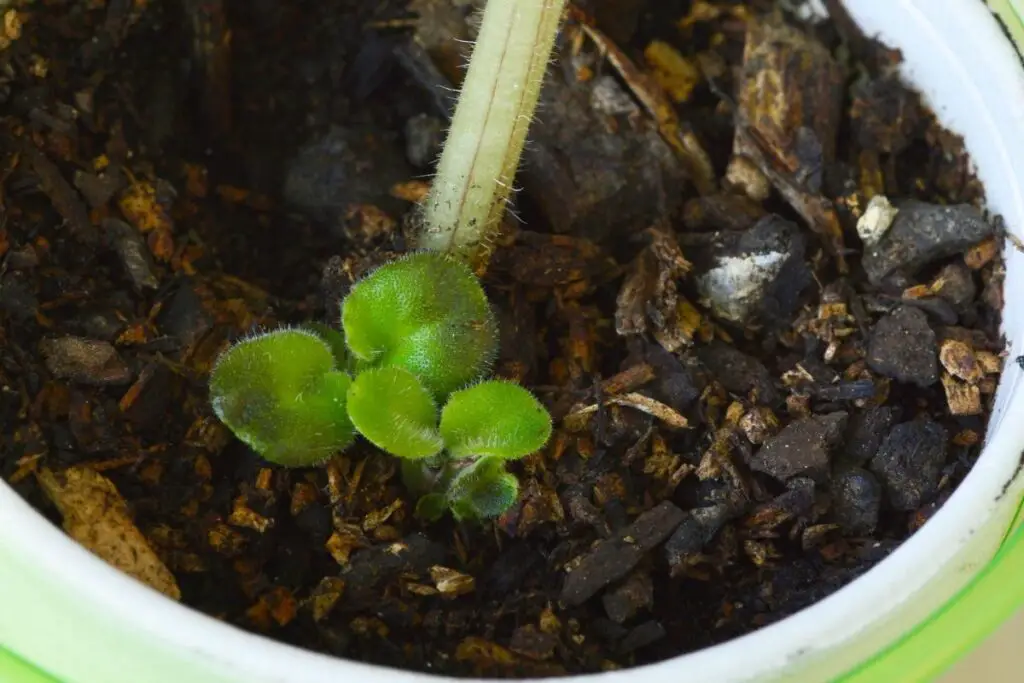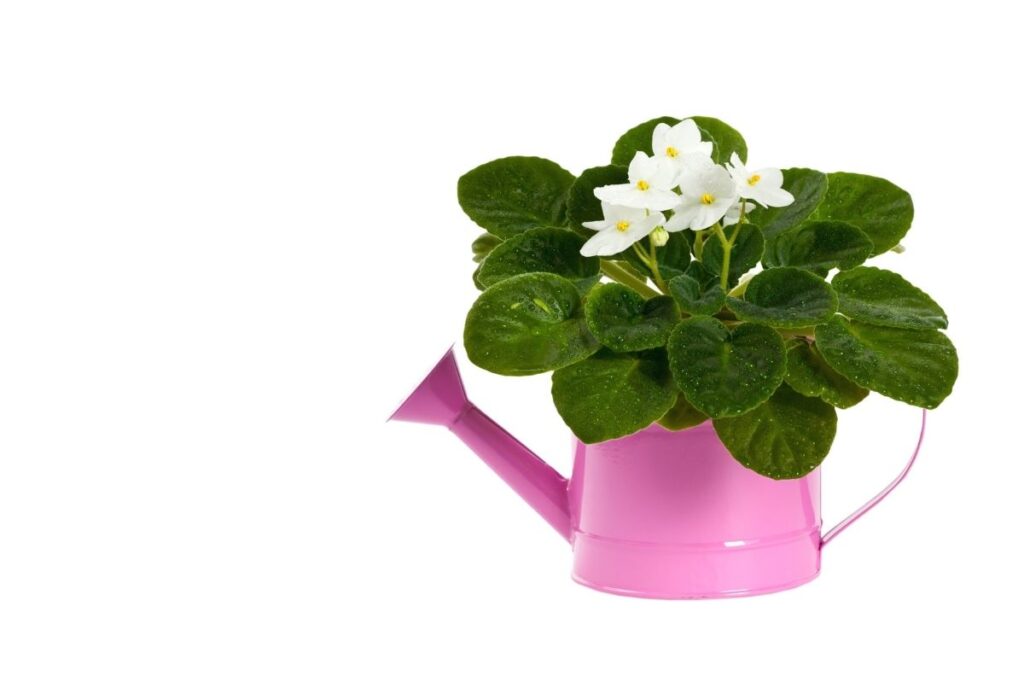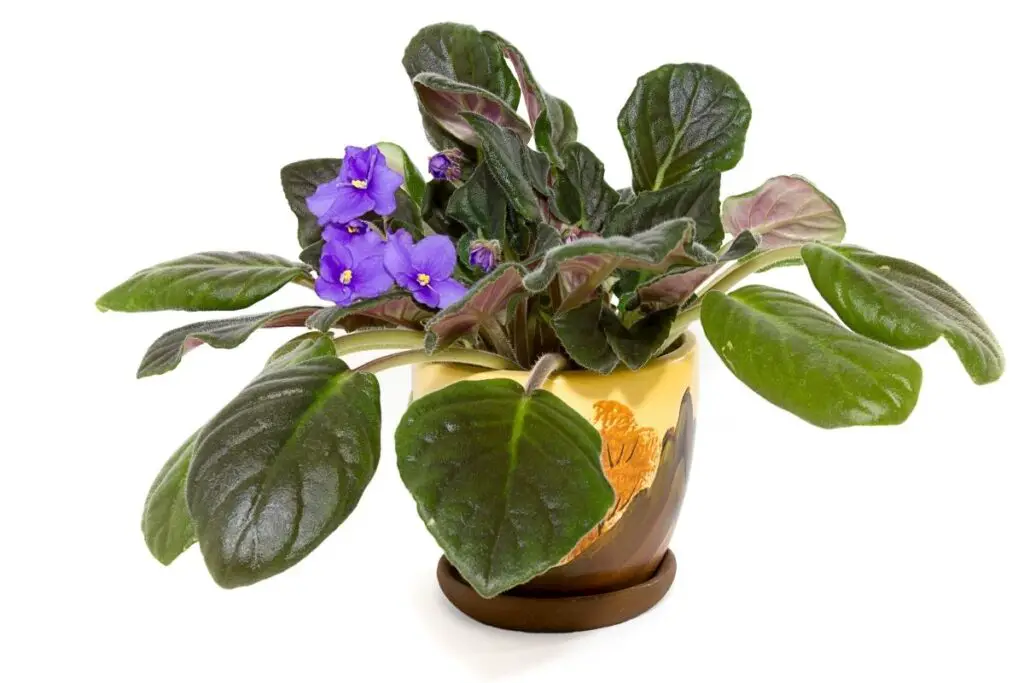African violets can always keep your garden filled with flowers. If you want good blooms, you need to learn the essential watering techniques for your African violets.
So, in this article, we shall discuss all about how often should African violets be watered and how to water them correctly.
In general, African violets need to be watered every 7-10 days, depending upon the soil moisture level. Check the topsoil between watering and make sure the top 1-2 inches of soil dry out a little bit before watering the plant again. Bottom watering also works excellent for African violets.
Water requirements of African violets are different, but it is not complicated.
If you are not sure about how to water them, continue reading the article, and you will get the answers to your questions regarding the watering techniques of these plants.

How often should I water the African violets?
African violets are particular about their watering needs. You need to provide them with the right amount of water for healthy growth. Less water or more water might cause harm to these flowers.
There is no specific rule for their watering. These violets can be planted and grown anytime, and they will bloom throughout the year. So, you must water them accordingly.
- During the rainy days, you should water them less as they would already be receiving enough water. Reducing the watering for some time will help the plant avoid overwatering issues.
- During the hot summers, you can water a little more to keep them cool. Excessive hot weather might result in stunted growth.
- During the winters, you must reduce the watering to keep them safe from cold weather.
If your African violets are planted in sand-based soil, the water will dry quickly, and you will have to water them frequently.
Sandy soil base will also help in draining the water quickly. If your soil bed has compost, then it might help a bit in retaining moisture.
You can add vermiculite to the soil bed while planting the African violets, and it will absorb all the excess moisture from the soil. If you are watering right daily, these components will do their job and help avoid overwatering.
If you are confused about the moisture level in your African violet soil bed, you can use a moisture meter to check it. This way, you can make determine whether they are getting the right amount of water.
Let the soil dry up a bit before the next watering to avoid overwatering.
Things to keep in mind while watering the violets
Here are two important factors that you need to consider to be on top of the watering game.
Proper drainage system
Make sure that the soil bed of the African violets has a sound drainage system. The clay content in the soil should not be too much as it might hold excess water.
Add vermiculite, compost, or sand to your soil bed while planting. These components will help the African violets to drain the excess water and, at the same time, will hold the actual amount of moisture that is needed for the plants to absorb nutrients.
Check the moisture of the soil

Make sure that the soil is not draining most of the water. African violets require consistent moisture in the soil to remain healthy.
To check the soil’s moisture level, use your fingers to touch the soil at the base of the plant. Or, stick your finger gently into the soil. You should probably wait till the next watering if it feels wet and let the soil dry up a bit more.
This will help to know that the soil is not holding any excess water, and this wait can give the soil enough time to drain and dry up all the excess water from it.
Looking for gardening supplies? We have tested 100's of products before recommending them to you guys. Check out our best pick below:
| Image | Gardening Supplies | Best Price? |
|---|---|---|
 Top
Top Top
Top | Raised Garden Bed Kit | Check On Amazon |
 | XLUX Soil Moisture Meter, Plant Water Monitor, Soil Hygrometer Sensor for Gardening, Farming, Indoor and Outdoor Plants, No Batteries Required | No Results |
 Top
Top Top
Top | 82 Pcs Garden Tools Set and Extra Succulent Tools Set | Check On Amazon |
 | Joeys Garden Expandable Garden Hose with 8 Function Hose Nozzle, Lightweight Anti-Kink Flexible Garden Hoses, Extra Strength Fabric with Double Latex Core, (50 FT, Black) | No Results |
 Top
Top Top
Top | Dual Chamber Compost Tumbler | Check On Amazon |
 Top
Top Top
Top | Sunnyglade Plant Stakes | Check On Amazon |
 Top
Top Top
Top | Organic Cold Pressed Neem Seed Oil | Check On Amazon |
 Top
Top Top
Top | Mighty Mint Gallon :-Insect and Pest Control Peppermint Oil | Check On Amazon |
 Top
Top Top
Top | Scotts DiseaseEx Lawn Fungicide | Check On Amazon |
 Top
Top Top
Top | Jacks Classic 20-20-20 All Purpose Fertilizer | Check On Amazon |
 Top
Top Top
Top | 30,000 Seeds Pollinator Attracting Wildflower Mixture | Check On Amazon |
 Top
Top Top
Top | Survival Vegetable Seeds Garden Kit-Over 16,000 Seeds | Check On Amazon |
Factors determining the water requirement for African violets
The water requirement depends on external and cultural factors. A little knowledge about these can help you understand the water requirements of your African violets.
Light
Since the African violets receive indirect sunlight, there is less chance that the water will dry up fast. But still, water might dry if they receive indirect sunlight for about 12 hours.
Lack of light affects the growth of the plant and doesn’t let the water dry up. If the water fails to dry up, it will make the soil bed soggy and damp. This might result in root rot in your African violets.
If the weather is not sunny but dull and damp, then you can avoid daily watering. On bright days, water them normally.
Also read: What Kind Of Light Does An African Violet Need? (African Violet Light Requirements)
Temperature
African violets need 70-80°F in the day and 65-70°F at night. These plants enjoy a warm and semi-humid climate for ideal growth, and they do not enjoy cold weather conditions at all.
In the hot summers, if the temperature rises too much, it might result in stunted growth. Hot temperatures result in slow growth and no blooms.
You can water them a bit more during the hot summers to keep the soil evenly moist. Make sure that you don’t end up overwatering the violets.
Try to use room temperature water as it will help keep the soil moist and the plant warm but not hot, and it will be helpful for the plant during the hot summers.
African violets do not like cold weather. You can reduce the water supply during the winters so that the violets don’t remain in cold and damp soil. This will help to prevent withered leaves.
Drainage
A well-draining soil is an essential factor that can determine the water requirements of the African violets. You can create a proper drainage system by using a well-draining medium.
Mixing some sand with the other components can improve the drainage system of the soil bed, and it will prevent the soil from being soggy.
Adding perlite to the soil will make the soil porous, which will also provide adequate drainage.
How much water do African violets need?

There are no definite rules about how much water these violets need daily or weekly. You can understand how much water it needs by checking the moisture content of the soil with your finger.
If you are bottom watering the plant, then you need about 700ml of water for a 6-inch pot. But make sure you remove excess water when the soil feels moist.
For top watering, you can slowly water the plant till the excess water starts draining from the bottom. However, make sure you don’t make the leaves and flowers wet.
During winter, water your plants only if you feel that the soil is dry. Excess water might result in damp and cold soil, leading to withered leaves and flowers.
Try to keep the plant warm. You can remove the shade (if you made any for protecting the plants from the harsh sun rays) so that they can get good sunlight. Let them receive the warm rays of the sun.
During summer, the African violets need frequent watering to get all the moisture they need. Hot temperatures will reduce their growth, and that is why good watering is necessary. But make sure you don’t make the plants stand in the water as the soft stems are susceptible to root rot.
During rainy days, it is better to stop watering for some days since they are constantly getting rainwater. So give your plant a break from manual watering.
But if they are receiving too much water from the rains, you can help the plant absorb the excess moisture by adding vermiculite to the soil.
If you have watered more, wait until the next watering and let the soil dry up. Using less water in each watering will not be a problem, and watering less will not cause any damages, which overwatering can.
What kind of water should be used for African violets?
The most suitable water for these violets is room temperature or tepid water, and you can even use tap water for the violets.
You can use spring water by buying them from the market. Rainwater is also a good choice for African violets. But if you stay in an area with low air quality and a high amount of pollution in the surrounding, it is better to avoid rainwater.
Avoid using distilled water as they lack many minerals.
Do not use water that has chloramine. Water that comes from cities sometimes contains chloramine.
Chloramine harms the plant, and the older leaves start showing signs like spots, black edges, and discoloration. It damages and slowly kills the plant if you don’t stop using this water.
You should immediately change the water once you see the probable signs in the plant.
What happens if you overwater the African violets?

Overwatering is always a problem for all flowering plants. One worst problem caused by overwatering is root rot. It mainly happens when you are constantly watering your plants without checking the soil or observing the reaction of your plants.
Another problem that can lead to overwatering is a poor drainage system. If the soil bed is not well-drained, your plants will surely face overwatering issues.
If you don’t treat the problem immediately, they will undoubtedly experience root rot sooner or later. If the stems of the plants remain soft due to their extended stay in the water, they start rotting and eventually end up dying.
Signs of overwatering
Sometimes, gardeners, as a rule of thumb, consider underwatering the African violet rather than overwatering.
Underwatered violets can be revived to some extent, but if the plants start suffering from root rot, reviving can become a struggle. The plant might even end up dying under challenging situations.
Now let us check the symptoms:
- Brown and mushy roots.
- Foul-smelling soil.
- The crown also will start to rot once the root begins rotting.
- The leaves will become limp and start turning yellow.
- The leaves will develop brown spots on them.
How to fix the problem?
Here are a few steps that will help you deal with overwatered African violets.
- Once you start seeing signs, immediately remove the affected leaves from the plant. If you notice anything severe, you should take out your plant from that particular place.
- After taking the plant out, gently remove the leftover soil from the roots. Avoid hurting the healthy roots and get rid of all the affected roots.
- You can plant the violet plant in some other place in the garden, where the soil is good. Improve the soil quality by adding compost, vermiculite, or perlite. This will help improve the drainage system.
- Avoid watering for at least a week. This will give your plant enough time to cure.
- After one week, slowly start watering if the plant shows signs of recovery. Keep checking the soil to avoid further overwatering.
If your plant is not recovering, then your plant might be severely damaged due to root rot and might die within one week.
In such conditions, you save the plant variety by cutting down the leaves for producing plantlets through propagation.
What happens if you underwater the African violets?

Although you can save under-watered African violets sometimes, most of the time, it can be harmful.
Signs of underwatered African violet
Some symptoms of underwatered African violets are:
- Your plant will become dry and crisp on the surface.
- The sides of the soil will pull away from the borders of the soil bed.
- The leaves will look dull, and there will be no shine on them.
- The leaves will become droopy.
- The leaves will become limp from the middle portion.
How to fix the problem?
You can fix your underwatered African violets in the following ways.
- If the leaves are becoming dull and limp, you will need to water your plant immediately.
- Water the plants according to the seasons. Keep in mind their ideal temperature and humidity, and water correctly.
- Adding perlite to the soil bed will help retain enough moisture needed for the plant.
- You can increase the water if the drainage system of the soil is working well. But make sure you don’t overwater.
- Insert your finger into the soil bed about, and if the soil doesn’t stick in your finger, but you notice some dry specks, probably your plant is under-watered.
Final words
The watering technique of the African violets might be slightly different from other flowers in the garden but nothing complicated. They grow the whole year. So you must water them accordingly.
You can change the watering conditions according to the seasons and weather changes, but maintain their temperature and humidity while watering them. Do not end up with complete dryness or overwatering issues.
Constantly keep the soil moisture in check by using your fingers. This is an easy way to know whether your plant needs water or not.
While watering, slowly water the plant close to the soil. You can gently push the leaves and water the soil visible in between the leaf gapping. Avoid splashing water on the leaves, crowns, stems, or flowers.
Source: Wikipedia, African violet: Classical breeding, African Violet Society of America, In vitro propagation of African violet, University of Florida, North Dakota State University, The University of Georgia.
